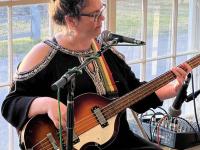Students' vegetables served for lunch
 Members of Michelle Miclette's sixth grade class pose with their lettuce and spinach plants. The students were eager to taste their product at lunch November 14. The green house, below, funded by grant money, provides a place for students to learn and grow vegetables. RYAN LEIGHTON/Boothbay Register
Members of Michelle Miclette's sixth grade class pose with their lettuce and spinach plants. The students were eager to taste their product at lunch November 14. The green house, below, funded by grant money, provides a place for students to learn and grow vegetables. RYAN LEIGHTON/Boothbay Register
 The green house, funded by grant money, provides a place for students to learn and grow vegetables. RYAN LEIGHTON/Boothbay Register
The green house, funded by grant money, provides a place for students to learn and grow vegetables. RYAN LEIGHTON/Boothbay Register
 Members of Michelle Miclette's sixth grade class pose with their lettuce and spinach plants. The students were eager to taste their product at lunch November 14. The green house, below, funded by grant money, provides a place for students to learn and grow vegetables. RYAN LEIGHTON/Boothbay Register
Members of Michelle Miclette's sixth grade class pose with their lettuce and spinach plants. The students were eager to taste their product at lunch November 14. The green house, below, funded by grant money, provides a place for students to learn and grow vegetables. RYAN LEIGHTON/Boothbay Register
 The green house, funded by grant money, provides a place for students to learn and grow vegetables. RYAN LEIGHTON/Boothbay Register
The green house, funded by grant money, provides a place for students to learn and grow vegetables. RYAN LEIGHTON/Boothbay Register
“Eat your vegetables.”
That phrase was all too familiar during childhood. But these days, the fifth and sixth graders at Boothbay Region Elementary School want to eat their vegetables – the ones they've harvested themselves.
Since September, the students in Michelle Miclette's fifth and sixth grade science classes have learned to grow their own lettuce and spinach, and have now incorporated those vegetables into the school cafeteria lunch.
On November 15, the sixth graders took their lettuce to the cafeteria and filled two large colanders with their crop. Following the proper sanitary procedures, the kids and the cafeteria staff prepped their produce for a lunch salad.
The students said they were eager to taste the “fruit” of their labor.
One of the hardest parts about growing the vegetables was waiting for their crop to pop up, the students said. As soon as the lettuce sprouted, it was very tempting to eat the leaves right out of the pot, but they were patient.
Miclette said the lettuce and spinach were grown completely organic, without any chemical fertilizers, and just worm castings used to enrich the soil's nutrients.
As part of a unit studying the role plants play on earth, the students learned about carbon cycles, pollination, fertilization and the importance of knowing where their food comes from.
Students spent 10 minutes a day working with their plants in the school's outdoor greenhouse. When the weather turned cold they brought their lettuce inside to store beneath grow lights set up in Miclette's classroom.
The greenhouse was made possible by the collective efforts of the school staff, grants and high school students, who built the structure. A National Semiconductor Co. Science-in-Action grant covered the cost of the grow lights and soil, and a 5-2-1-0 grant helped pay for gardening supplies and clearing the land for the greenhouse.
School nurse Lori Grinnell, who applied for 5-2-1-0, said the grant also has a lot to do with promoting healthy eating practices.
Healthy school lunches
Food Service Director Darlene French was just as excited as the kids to be providing vegetables grown from the school's greenhouse. She said the lettuce was the start of a movement to produce more student grown vegetables at BRES.
Since September, the cafeteria has adhered to the federal and state guidelines that require a daily ration of fruit and vegetables for every hot lunch served. French said 3/4 cup of vegetables have to be on the tray, and that each student must have at least three of the five components: meat; bread; milk; vegetables and fruit, in order to come through the line.
According to French, the school has been buying their food from local farms as much as possible. Whether it's squash from Spears Farm in Nobleboro, potatoes from Aroostook County or cheese from Farm Fresh Connection (a state organization that provides local food for Maine schools), the advantages are that the school saves money and they know exactly where the food is coming from.
French said she and Miclette plan to have the students grow an herb garden after the holidays. Miclette said with as much excitement that was generated with the lettuce, she plans to produce more vegetables every year with her students.
In a nation struggling with a childhood obesity and failing school health standards, BRES is one place healthy eating is being practiced at the community level; and Michelle Miclette is making sure her students learn how science affects the world around them, one head of lettuce at a time.
Event Date
Address
United States


























